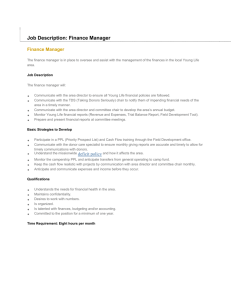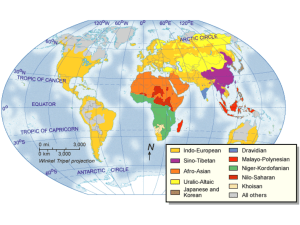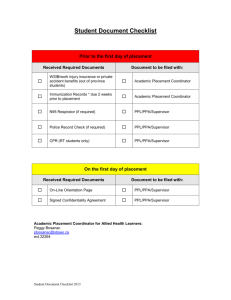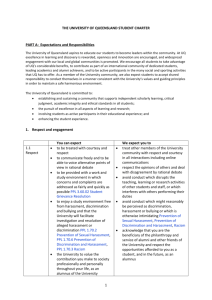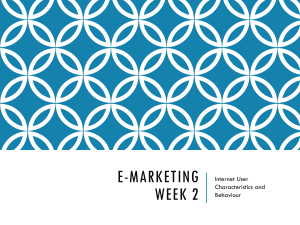PAID PARENTAL LEAVE (FOR EMPLOYEES) The purpose of the
advertisement
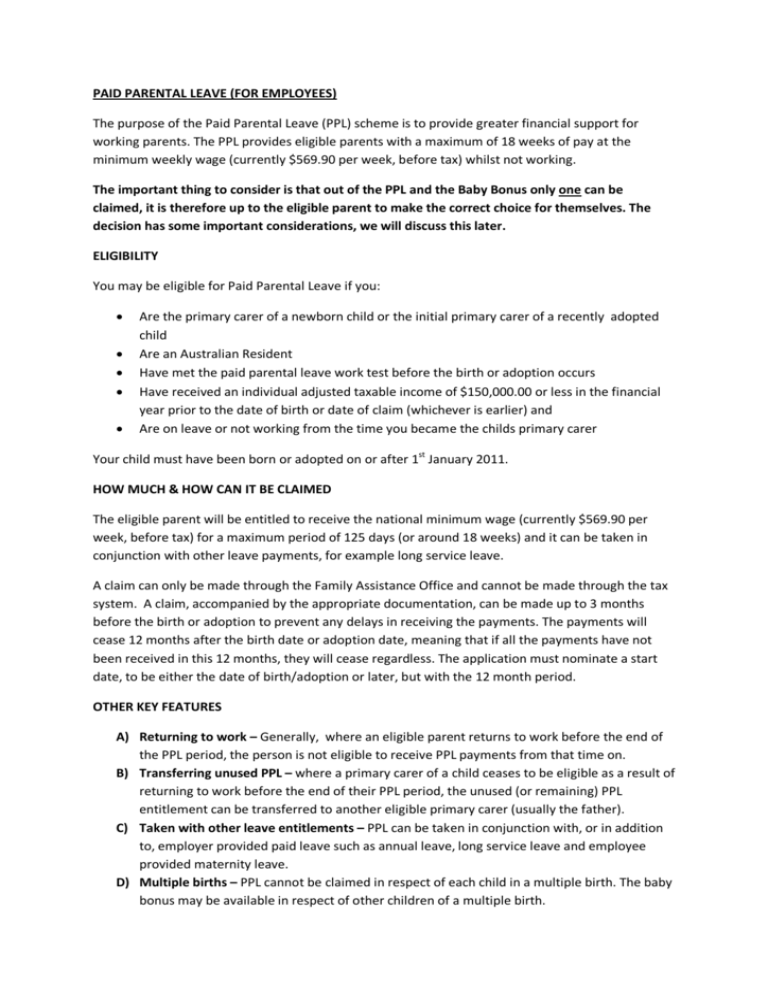
PAID PARENTAL LEAVE (FOR EMPLOYEES) The purpose of the Paid Parental Leave (PPL) scheme is to provide greater financial support for working parents. The PPL provides eligible parents with a maximum of 18 weeks of pay at the minimum weekly wage (currently $569.90 per week, before tax) whilst not working. The important thing to consider is that out of the PPL and the Baby Bonus only one can be claimed, it is therefore up to the eligible parent to make the correct choice for themselves. The decision has some important considerations, we will discuss this later. ELIGIBILITY You may be eligible for Paid Parental Leave if you: Are the primary carer of a newborn child or the initial primary carer of a recently adopted child Are an Australian Resident Have met the paid parental leave work test before the birth or adoption occurs Have received an individual adjusted taxable income of $150,000.00 or less in the financial year prior to the date of birth or date of claim (whichever is earlier) and Are on leave or not working from the time you became the childs primary carer Your child must have been born or adopted on or after 1st January 2011. HOW MUCH & HOW CAN IT BE CLAIMED The eligible parent will be entitled to receive the national minimum wage (currently $569.90 per week, before tax) for a maximum period of 125 days (or around 18 weeks) and it can be taken in conjunction with other leave payments, for example long service leave. A claim can only be made through the Family Assistance Office and cannot be made through the tax system. A claim, accompanied by the appropriate documentation, can be made up to 3 months before the birth or adoption to prevent any delays in receiving the payments. The payments will cease 12 months after the birth date or adoption date, meaning that if all the payments have not been received in this 12 months, they will cease regardless. The application must nominate a start date, to be either the date of birth/adoption or later, but with the 12 month period. OTHER KEY FEATURES A) Returning to work – Generally, where an eligible parent returns to work before the end of the PPL period, the person is not eligible to receive PPL payments from that time on. B) Transferring unused PPL – where a primary carer of a child ceases to be eligible as a result of returning to work before the end of their PPL period, the unused (or remaining) PPL entitlement can be transferred to another eligible primary carer (usually the father). C) Taken with other leave entitlements – PPL can be taken in conjunction with, or in addition to, employer provided paid leave such as annual leave, long service leave and employee provided maternity leave. D) Multiple births – PPL cannot be claimed in respect of each child in a multiple birth. The baby bonus may be available in respect of other children of a multiple birth. E) Children who are stillborn or who die – a claim can be made for a child who was stillborn or who has died, under special rules. CONSEQUENCES FOR ELIGIBLE PARENTS MAKING A CLAIM AND RECEIVING PAYMENTS PPL payments are assessable and subject to PAYG withholding – The payments are considered to be ordinary income and are to be included in the Tax Return in Item 1, Salary & Wages whether received by the FAO or by the Employer. PPL payments can be salary sacrificed – When PPL payments are received from the employer they can be subject to salary sacrifice arrangements. Included as income for other concessions – As PPL payments are considered to be ordinary income, they will generally affect entitlement to, or liability for, certain tax and non-tax concessions and obligations whose income tests are linked to taxable income, such as the following Family assistance payments (eg. FTB Part A and Part B and Child Care Benefit) Low income or other Health care Cards Child support obligations Certain Tax Offsets (eg. Pensioner, Beneficiary and Dependant Spouse Offsets) Medicare levy surcharge and HELP Repayments FTB Part B and certain tax offsets not available – FTB Part B along with the dependant spouse, child housekeeper, housekeeper and beneficiary tax offset will generally not be paid to a recipient while they are receiving PPL payments. FTB Part B will be available for the recipient for the remainder of the year if eligible. Baby Bonus not available – The Baby Bonus, which is currently paid at the non taxable amount of $5,294.00 for a newborn or adopted child, will not be available in respect of a child where PPL payments are being received in respect of that child. (unless in a multiple birth as discussed above) MAKING THE RIGHT CHOICE Parents must carefully consider whether the net benefit of making a claim under the PPL scheme (eg. Receiving PPL payments and a reduced level of any other entitlements) exceeds the net (after tax) benefit of not making a PPL claim (eg. Receiving the Baby Bonus and a higher level of any other entitlements) Here are some factors to consider when making the decision The length of the eligible PPL period – The longer the period over which the PPL is paid, the greater the benefit received. The 18 week period will generate a pre-tax total benefit of $10,258.00. Expected return to work – If an eligible parent expects to return to work this will reduce the amount that can be received under PPL as the payments cease at that point. In contrast under the Baby Bonus (maximum claim of $5,294.00 over a 26 week period) is not reduced because a parent returns to work early. General income level – Eligibility for the PPL is only dependant on the income level of the claimant only, that being an adjusted taxable income of $150,000.00. The Baby Bonus is based on the combined family income of the claimant and their spouse or partner (ie. The family’s adjusted taxable income must not exceed $75,000.00 within the 6 month period after the birth or adoption of the child) PPL affects other concessions/obligations – PPL payments can reduce entitlements to FTB Part A and certain tax offsets and create or increase liability to obligations such as Medicare Levy Surcharges and HECS repayments. Number of Children – As the number of children increases, then so does FTB Part A and B. If the claimant elects to receive PPL payments these extra payments can be reduced or cut-off. TO ASSIST CLAIMANTS IN MAKING THE MOST BENEFICIAL DECISION, CENTRELINK HAS CREATED A PPL COMPARISON ESTIMATOR. IT IS AN ONLINE CALCULATOR WHICH PROVIDES A ROUGH GUIDE ON WHETHER AN ELIGIBLE PARENT IS BETTER OFF CLAIMING PPL OR THE BABY BONUS, TAKING INTO ACCOUNT FTB PART A AND PART B, BASIC INCOME TAX AND THE LOW INCOME TAX OFFSET. THE CALCULATOR CAN BE FOUND BY CLICKING ON THE FOLLOWING LINK http://www.centrelink.gov.au/internet/internet.nsf/individuals/ppl_working_parents_estimator.ht m For a comprehensive explanation of the Paid Parental Scheme please visit the Family Assistance website or click on the following link http://www.familyassist.gov.au/payments/family-assistance-payments/paid-parental-leave-scheme/

